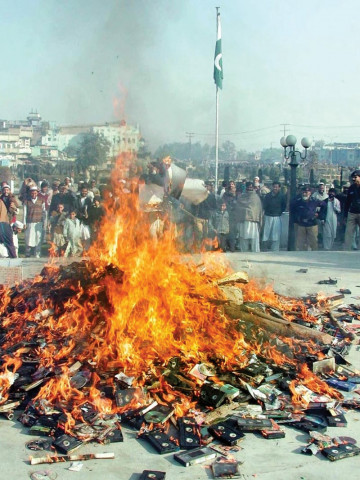
Music is a power tool, a psychotropic not hindered by the blood-brain barrier. It is why music has been used over the epochs to propagate, to agitate, to pacify, to woo and to emancipate. And this is why music is the one form of expression that scares the subjugator for striking a chord which can give a person, a state, a culture freedom.
It is this diminishing freedom that a report by the Center for Peace and Cultural Studies (CPSC), a non-profit research centre, talks about, a copy of which is with The Express Tribune. Music and Militancy (Buneri, Arif and Hassanzaib, 2014), soon to be published, highlights the shrinking space for musicians, instrumentalists, singers and dancers in an area being torn by political instability and militancy.
Though it usefully charts out the journey of the region in terms of freedom to express through performing arts, a majority of the data is based on news reports, making it more of a literature review than a research paper.
It touches on the cultural clay Pukhtuns take form from –their roots in Zoroastrian, Gandhara, Iranian, Central Asian heritage. Above all, the rough, vibrant fabric of tribal customs stitched together with a strong love for the ground they walk on. The fact that some of the definitive Pukhtun figures are poets gives an inkling about how music, rhythm are an ancestral linchpin.
As the paper explains, the politically and personally polarising forces of Wahabi religiosity and traditional secularism, triggered by the Soviet war and Ziaul Haq, left K-P’s musicians little space.
Music and Militancy shares that right wing parties like the Jamaat-e-Islami spread its tentacles to university campuses as well as the streets. Even then, till the 90s, Peshawar was a supportive cradle for those musicians who had to flee the Taliban in Kabul. But as the report explains, a “great damage was already done.” After 9/11, the musical landscape grew bleaker and darker. The report discusses the impact of the tricky dalliance between the Pakistani state and the Taliban, which led to the militants gaining a stronger foothold in K-P and Fata. After the provincial government of the now defunct Muttahida Majlis-e-Amal, shut down Nishtar Hall, banned music shops and burned tapes and CDS, music died a little every day. And after the Taliban took hold of Swat, musicians in Mingora and other areas were either run out of town or worse, killed, shares the paper.
Although, Music and Militancy explains, the Awami National Party’s (ANP) government tried to rectify the situation by reopening Nishtar Hall and setting up the culture department. Even though the ANP tried to reclaim space in K-P, things remained the same – if not worse – in Fata. Many of the elders were killed during the initial influx of militants in Fata, and even rudimentary music studios there were shut down.
The persecution of the art and its artists
One of the authors of the report, Shaheen Buneri told The Express Tribune the first instance of censorship he noted was in Swat. “In 2006, the Taliban termed dish antennas, computers and TVs as against the injunctions of Islam. People started collecting their tape recorders and antennas and put these on fire.”
He added, “In 2008, even local officials visited music centres and removed CD and cassette covers, terming them against religion... I observed that under pressure from the militants, authorities were discouraging music centres.”
According to the paper, trying to cleanse Dabgari Bazaar in Peshawar and Banr Street in Mingora – two areas which were homes to musicians – had a devastating impact on the freedom of music and musicians. First they came for the women singers and dancers, then they came for the other musicians and then the transgender performers. In fact, according to the paper, Swat was possibly the only place where women from families of professional musicians could carry on in their footsteps but no more. A more subversive censorship came through intimidation, shares the report. Singers were kidnapped, and then under duress forced to publically denounce their profession. Some started singing naats instead.
“In January 2012, singer Nazia Iqbal announced quitting singing...later she rejoined her carrier and said her kids had been threatened,” read the report.
The art of dying
It states between 2008 and 2012, at least 18 people were killed because of their relationship with music – either through militant acts or socio-familial reactions. The paper goes on to say of these 18, 12 were women.
“The stage for killing female singers was set by the TTP Swat chapter in January, 2009...TTP militants punished Shabana for dancing at a wedding in Mardan....She was dragged to Green Square where she was shot dead and her body hanged as a warning for others.” This was followed by many brutal murders over the notions of honour pegged in patriarchy. A more recent illustration is the Kohistan case where girls were allegedly killed for clapping in a video.
The report goes on to discuss the forms of forced, self-censorship or the silencing of musicians. Kidnappings, torture, threats to life, attacks on shrines, CD shops and even wedding ceremonies, and the closure of instrument shops all just highlight what Buneri says is, “an issue not on the priority list of the government or society.”
Published in The Express Tribune, March 3rd, 2014.












COMMENTS
Comments are moderated and generally will be posted if they are on-topic and not abusive.
For more information, please see our Comments FAQ